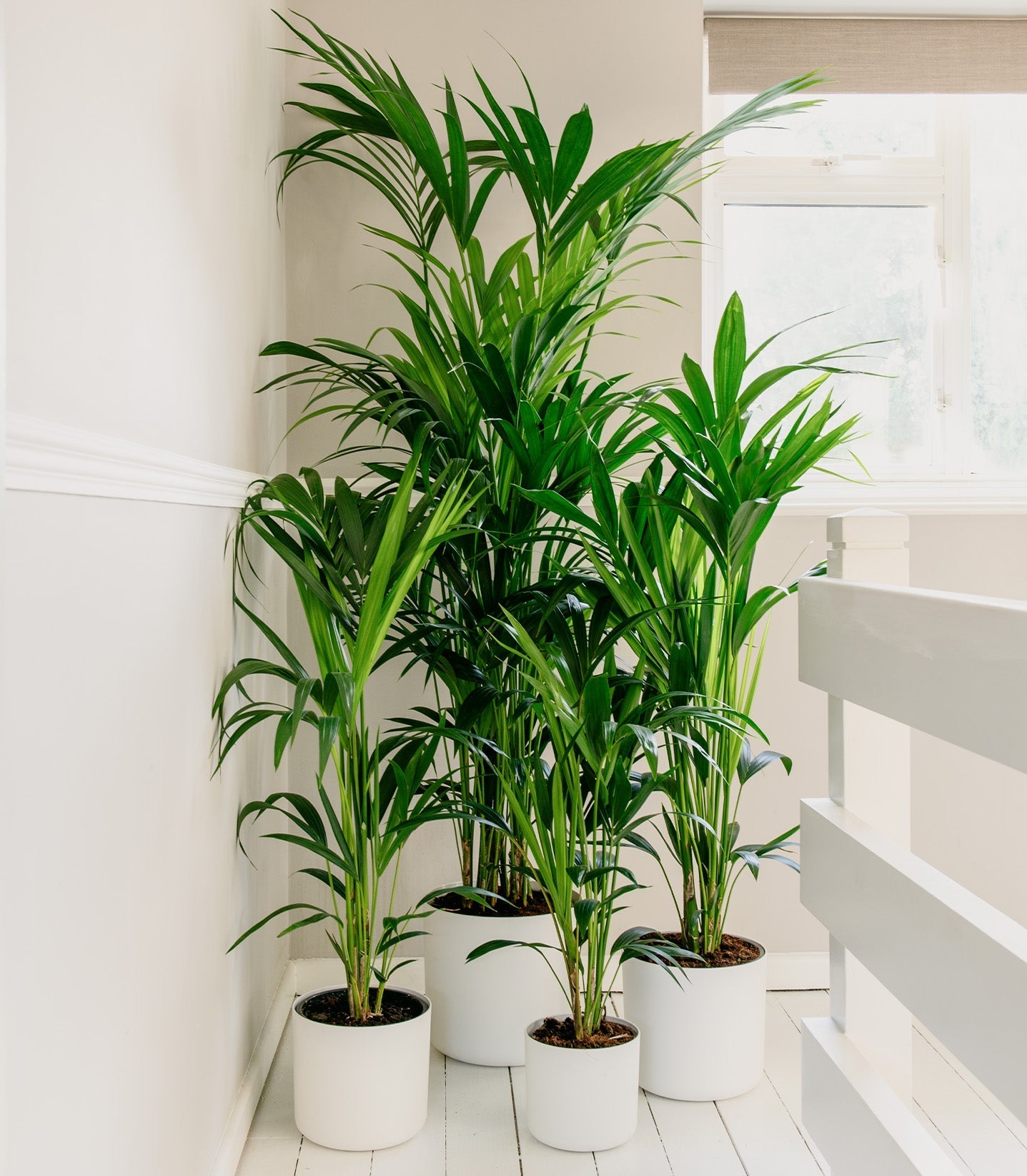
How to Keep Your Kentia Calm
The Kentia Palm (Howea Forsteriana) is like that effortlessly cool friend who brings a touch of the exotic to your indoor house plant collection. As one of the most popular tall house plants, this elegant floor plant is surprisingly low-maintenance… most of the time. But just like any relationship, there are a few bumps along the way.
The Plant Folk and Beards & Daisies are here to help you navigate the most common Kentia Palm problems!
Browning Tips Are A Kentia’s Cry for Help
The Problem: Browning tips are probably the number one complaint from Kentia Palm owners. You lovingly water, feed, and care for your house plant; in return, you get crispy brown tips. Rude!
The Cause: Browning tips can be caused by a variety of factors. Too much direct sunlight, inconsistent watering, or even the mineral content in your water can stress your Kentia Palm, leading to those unsightly brown edges.
The Fix: Think of your Kentia Palm as a shade-loving beach bum. It thrives in bright, indirect light, so keep it out of harsh, direct sunlight. Water consistently, but don’t overdo it, let the top 2 inches of soil dry out before watering again. If you suspect your tap water is the culprit, try using filtered water, rainwater, or letting tap water sit out overnight to allow the chlorine to dissipate.
Pro Tip: You can trim those brown tips with sharp, clean secateurs to keep your Kentia Palm looking sharp. Just be careful not to cut into the healthy green part of the leaf!

Yellowing Leaves Are A Classic Overwatering Sign
The Problem: One day, you notice your Kentia Palm’s lush green leaves are turning yellow.
The Cause: Yellowing leaves are often a sign of overwatering. While your Kentia Palm does love a good drink, it doesn’t want to be drowning in it.
The Fix: First, check the soil. If it’s soggy or waterlogged, your palm’s roots might be suffocating. Ease up on the watering and ensure your plant's pot has good drainage. If the soil is compacted and not draining well, it might be time to repot your palm with a well-draining potting mix.
Pro Tip: Invest in a moisture meter if you’re unsure about when to water. This handy gadget takes the guesswork out of watering and ensures your Kentia Palm stays in the Goldilocks zone, just right!
Drooping Fronds Making Your Palm Look Sad
The Problem: A healthy Kentia Palm has fronds that stand tall and proud. But when those fronds start to droop, it’s your plant telling you, “I’m not feeling so great.”
The Cause: Drooping fronds can be due to a variety of issues, including underwatering, low humidity, or even a lack of nutrients.
The Fix: Start by checking the soil moisture. If it’s dry as a bone, give your palm a good soak, but don’t let it sit in water. Next, consider the humidity. Kentia Palms hail from a sub-tropical paradise, so they’ll appreciate a little extra moisture in the air. Use a humidifier or mist your palm regularly. Finally, feed your indoor house plants with a balanced, water-soluble fertiliser during the growing season (spring and summer) to ensure it’s getting all the nutrients it needs.
Pro Tip: If you’ve tried everything and your Kentia Palm still looks sad, it might be root-bound. Check the roots; if they’re circling the pot, it’s time to upgrade to a larger home.

Unwelcome Guests… We Mean Pests!
The Problem: Just when you think your Kentia Palm is thriving, you spot some unwelcome guests, spider mites, mealybugs, or scale insects. Gross… but entirely normal!
The Cause: Pests love dry environments and often hitch a ride on new plants or through open windows. Once they find your Kentia Palm, they settle in and start causing trouble.
The Fix: First, give your Kentia Palm a good shower to dislodge as many pests as possible. Next, wipe the leaves with a mixture of water and mild dish soap or insecticidal soap. For persistent pests, you may need to escalate to a neem oil spray, which is effective and safe for indoor plants.
Pro Tip: Prevention is the best cure! Regularly inspect your plants for early signs of pests and keep the humidity up to make your Kentia Palm less inviting to these tiny invaders.
Leaf Spotting Creating a Polka-Dot Palm
The Problem: You notice brown or black spots appearing on the leaves of your Kentia Palm. It’s not the trendy look you were going for.
The Cause: Leaf spots can be caused by fungal infections, which often result from overwatering or poor air circulation.
The Fix: Start by removing the affected leaves to prevent the spread of the fungus. Then, ensure your Kentia Palm isn’t sitting in water and that it’s placed in a spot with good air circulation. If the problem persists, you may need to treat your palm with a fungicide.
Pro Tip: Water your Kentia Palm at the base rather than from overhead to keep the leaves dry and discourage fungal growth.

Keeping Your Kentia Palm Happy
Your Kentia Palm is a resilient and elegant plant that, with a little love and care, will reward you with years of tropical vibes. Remember, most problems stem from too much or too little of something, light, water, humidity, or nutrients. By finding that perfect balance, you’ll have a happy, healthy Kentia Palm that’s the envy of every plant lover.
So next time your palm throws a tantrum with brown tips or yellow leaves, don’t panic! You’ve got the tools, tips, and friendly plant folk (that’s us!) to help you out.
Dreaming of a plant paradise? Explore our wide collection of houseplants, from virtually unkillable and artificial plants to rare and unusual varieties. Whether you're looking for easy-to-care-for plants, air-purifying champions, or large and tall statement pieces, we have something for everyone. Shop our collection today!